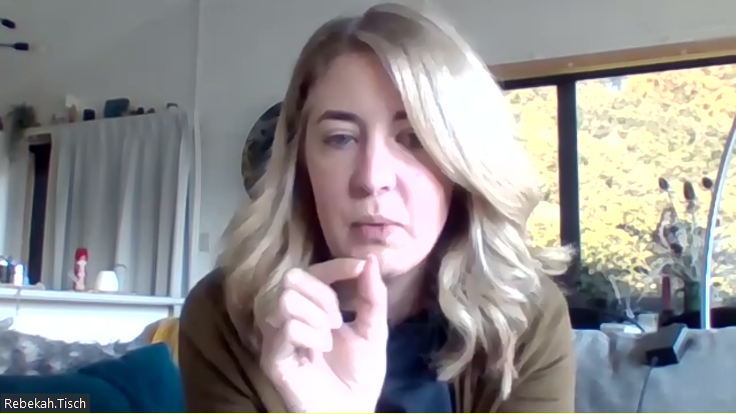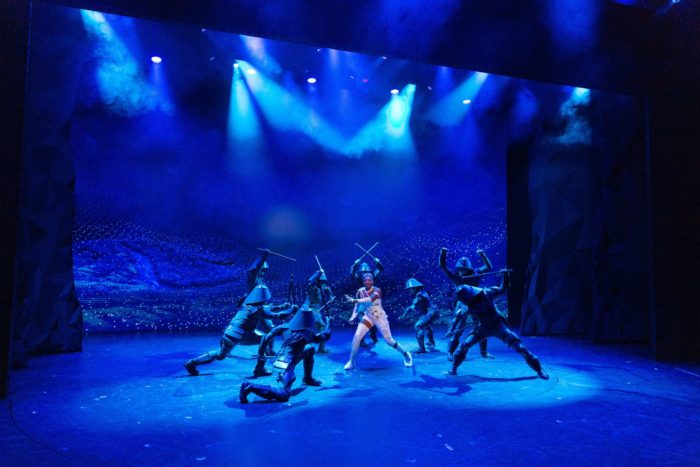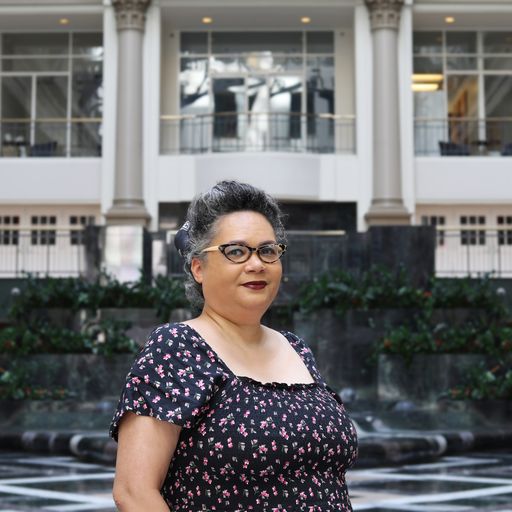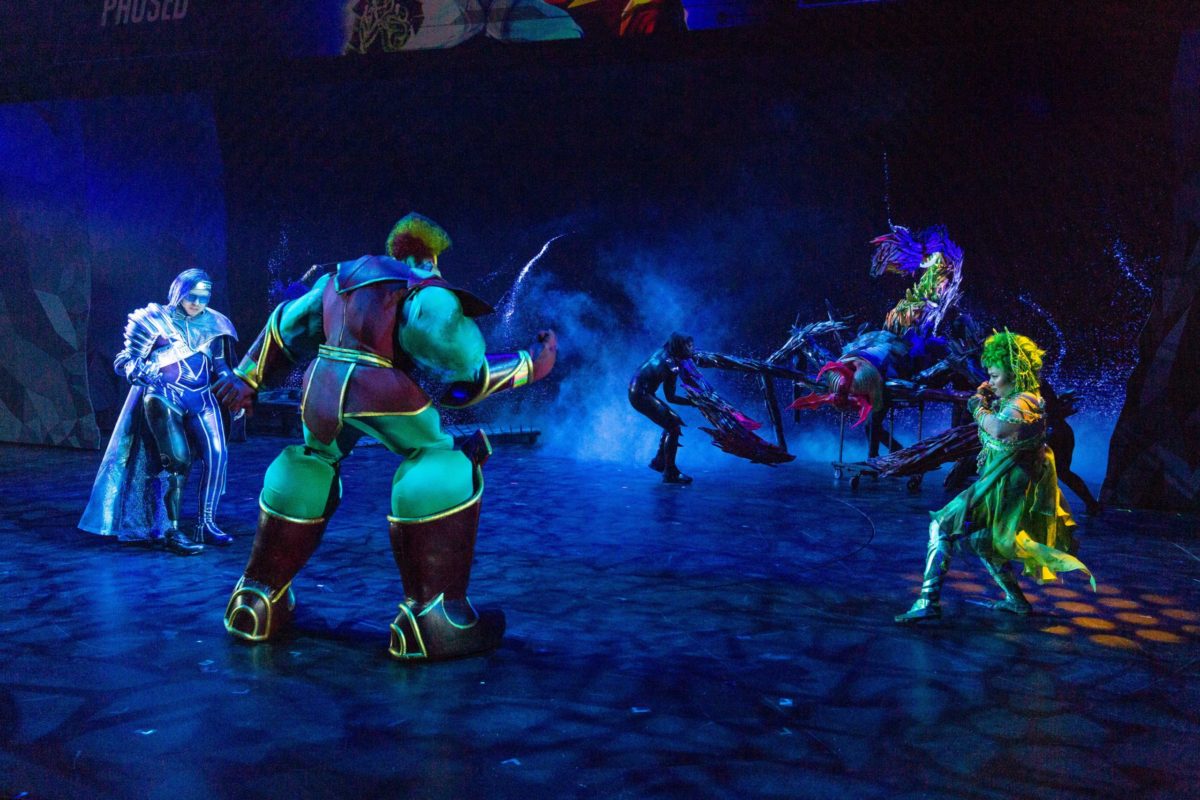Digital and physical worlds are colliding at the Delaware Theatre Company right now.
In “Other World,” the live musical that’s currently having its premiere run at the Wilmington theater, a fictional video game comes to life in front of the audience’s eyes. New Zealand’s famed Wētā Workshop, best known for the “Lord of the Rings” film trilogy, helped make it happen.
“Other World” does a lot of things: It’s an energetic musical with cast that shows the true diversity of gaming communities, it touches on issues like overcoming loss, and it transports the audience inside the game itself with the help of live special effects, both practical and technical.
You don’t hear a lot about firms on the level of Wētā Workshop contributing to new theatrical shows in Delaware. So, how did that happen?
First, it helps to know that DTC develops new shows for Broadway and off-Broadway, and that big Broadway musicals take years of workshopping and developing before they’re ready to open in New York.
Most of the development over the years for “Other World” has been done in New York. It was nearly a decade ago, early in development when it was a concept and a couple of songs, when, while in early development of the show, project collaborator Ann McNamee approached Wētā Workshop — which is, at the end of the day, a creative firm — for creative ideas.
Rebekah Tisch was one of the Wētā designers who took on the project from the beginning. She, along with designer Brooklyn Dineen, met with Technical.ly via Zoom from New Zealand.
-

Rebekah Tisch. (Screenshot)
“The writer, Hunter [Bell], came over, and we had a little bit of writer’s workshop and thought about what it could be, what it needed to communicate how to create some level of reality about about a game world. What are the tropes that gamers want to see in a in a theatrical version of the game?” she said. “And after that, it became about developing conceptual ideas about the visuals and how they manifest on stage. We tried a lot of different things over the years. Some of them were practical and physical. Some of them were purely just ruminating. But ultimately, we came to the conclusion that we would do what we do best, which is design imaginary worlds, as opposed to design something for theater.”
This reporter attended a run-through of “Other World,” directed by Adrienne Campbell-Holt, the day before the premiere. Watching the show, you find yourself in two worlds: the “IRL” world of the gamers, and Other World, the open-world game filled with avatars, challenges and bosses. Human characters are pulled into the game and NPCs (non-playable characters) become more human to a catchy Broadway style music and lyrics by Jeff Bowen and Ann McNamee.
If you find the fictional game realistic, even complex, a lot of it is because of the development work of Tisch and her team, who actually developed “Other World” as a complete game — but, instead of coding it, they used it as a “real world” setting for the characters and creatures.
“We specialize in adding a visual depth to a world or a concept,” Tisch said. “So I thought, what if I design what the game looks like? What if I create visual world rules for that game? What if I create a color palette for a designer, the various different locales that we visit and some other locales. Obviously, it’s a bit tricky because it’s not a functional game. It was more like designing the aesthetic cladding for a functional game, which sounds a little bit ridiculous, and it’s possibly a first of its kind, a game that’s not actually a game.”
Creating the game was an early part of the show’s development that would impact the the way it would ultimately manifest itself.
“I think it had quite a big impact on the assets and the imagery used in the show,” she said. “Different digital assets, like a tree that was designed as part of the design process for the game, show up [in the final show].”

A scene in “Other World.” (Courtesy photo)
The biggest challenge was the combining of a digital landscape with the theater: If there is too much digital, the audience may not feel like they’re getting a live experience.
“Something that I discovered over our years of trial and error was that the things that people love about the theater don’t necessarily correlate with the things people love about video games,” Tisch said. “A lot of things in the theater need to be physical, because that is what you’re ultimately there to connect with, as physical beings sitting in a seat watching a show. And so it was about trying to limit the amount that we depended on video to create that feeling of immersion that needed to come from the set designer, the lighting designer, the choreographer, all of those things that are physical on a stage and has a tried and true methodology around engaging with an audience.”
Even at the run-through, with its limited audience, “Other World” made that connection, the large and complex set pieces even more impressive as physical things being witnessed in a real, in-person space. It’s an unusual kind of immersion in a time when fully immersive gaming is becoming increasingly popular — where the (puppet) creature hovering feet from your face is physically there.
“Other World” runs through March 20.
Before you go...
Please consider supporting Technical.ly to keep our independent journalism strong. Unlike most business-focused media outlets, we don’t have a paywall. Instead, we count on your personal and organizational support.
3 ways to support our work:- Contribute to the Journalism Fund. Charitable giving ensures our information remains free and accessible for residents to discover workforce programs and entrepreneurship pathways. This includes philanthropic grants and individual tax-deductible donations from readers like you.
- Use our Preferred Partners. Our directory of vetted providers offers high-quality recommendations for services our readers need, and each referral supports our journalism.
- Use our services. If you need entrepreneurs and tech leaders to buy your services, are seeking technologists to hire or want more professionals to know about your ecosystem, Technical.ly has the biggest and most engaged audience in the mid-Atlantic. We help companies tell their stories and answer big questions to meet and serve our community.
Join our growing Slack community
Join 5,000 tech professionals and entrepreneurs in our community Slack today!

Millions of dollars pour into semiconductor manufacturing in Southwestern PA

Top tech stories of 2024: How AI, cyber and community made DC innovation sing



